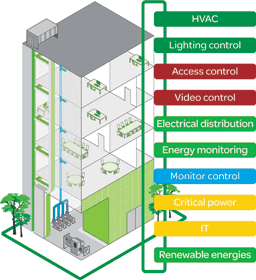

The larger and more economically viable a city is, the more buildings and infrastructure it has. Ironically it is also these structures that sap a city of its energy and a business of its profitability.
According to Artur Socha, Buildings Division product manager at Schneider Electric South Africa, buildings have long ago moved on from being only a supportive means to house employees and run a business. “Energy efficiency has moved to the fore of the overall business strategy. Executives not only have to look at their core business, they also have to take an holistic view of their building, identifying how it functions and operates and how the space will be occupied. This will allow the company’s physical infrastructure to play a major role in its profitability. More than ever, energy efficiency is crucial to the creation of high performance buildings and business success,” he says.
South Africa’s Department of Minerals and Energy (DME) has set a national target for energy efficiency improvement of 12% by 2015. In its energy efficiency strategy for South Africa, the DME says that commercial and public buildings account for 3,5% of final energy demand. The commercial sector alone contributes 45% towards total national GDP. It further states that “the majority of energy is used in the form of electricity, the main end-users being HVAC systems, lighting and office equipment.”
The vision is to contribute towards affordable energy for all and to minimise the negative effects of energy usage upon human health and the environment. “As a global specialist in energy management, Schneider Electric takes an integrated approach to building management, which has the potential to reduce energy use by 30%, reduce capital expenditure, decrease operating expenditure and improve overall business performance,” continues Socha.
Targeting the southern African building environment, Siemens has developed solutions for both medium and large sized buildings. These solutions are made up of enabling products, management systems and added value services. Enabling products include:
* Lighting control: dimmers, timers, switches, movement and presence detectors.
* HVAC: variable speed drives for flow and pressure control of fans and pumps.
* Energy management: power compensation and filtering, meters.
* Renewable energy: systems for the production of solar energy.
Management systems encompass building management systems and power monitoring and analysis. Added-value services include site audits, data collection and analysis, financial analysis and return on investment, improvement plans, and remote monitoring and optimisation.
“In our four-step approach, we measure energy use to identify potential savings and dysfunctions; install low-consumption equipment and systems; improve long-term use by deploying automation management, consulting, training and tracking resources while maintaining high performance; and continuously analyse energy savings through maintenance, supervision and monitoring,” adds Socha.
In 2011, the DME made the SANS 204 standard for office buildings mandatory and incorporated it into the National Building Regulations. It is now policy that buildings must conform to the building energy efficiency requirements as set out in this specification. As energy experts, Schneider Electric has vast experience with different regulations worldwide and a great knowledge base from which to work effectively and quickly.
“Improving energy efficiency should not be an overwhelming task. When taking into account the 2010 Jakarta presentation by the International Energy Agency, which showed that 50% of the world’s CO2 emissions reduction will come from end-user efficiency by 2035, it should be viewed as a positive measure to reduce the environmental footprint of a company whilst also achieving business goals,” Socha explains. “Importantly, energy efficiency applies both to old and new buildings. In fact, it has been especially satisfying to see the astounding environmental and monetary outcomes of Schneider Electric’s energy efficiency solutions when implemented in older buildings on university campuses and the like. In the near future, the most powerful companies and institutions will be those with the least power,” he concludes.
For more information contact Belinda Aslett, Schneider Electric, +27 (0)11 254 6400, [email protected], www.schneider-electric.com
| Tel: | +27 11 254 6400 |
| Email: | [email protected] |
| www: | www.se.com/za/en/ |
| Articles: | More information and articles about Schneider Electric South Africa |

© Technews Publishing (Pty) Ltd | All Rights Reserved